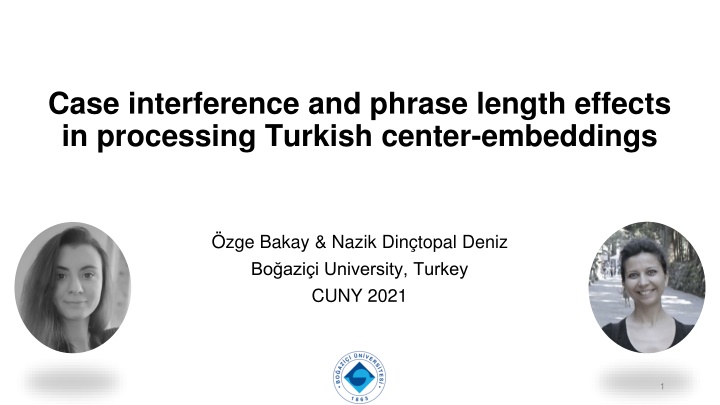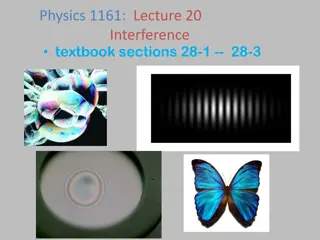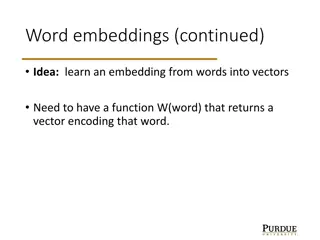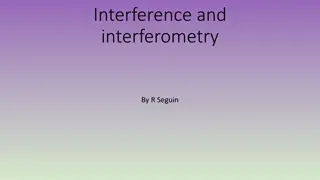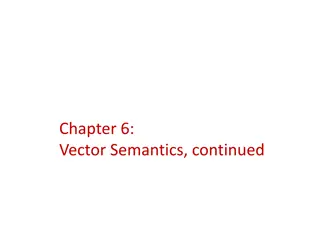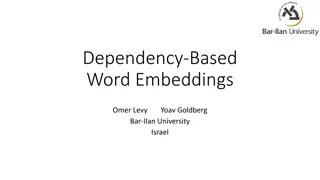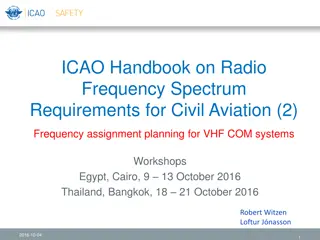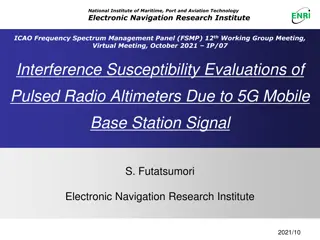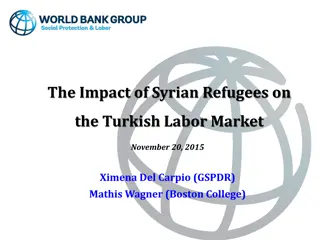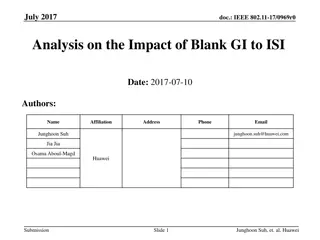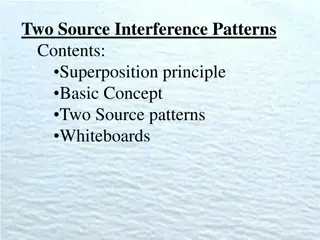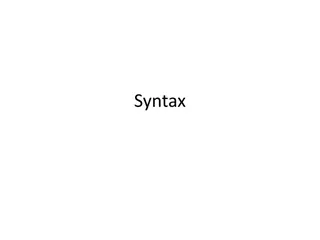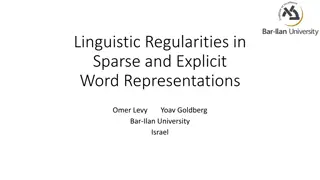Processing Turkish Center-Embeddings: Case Interference and Phrase Length Effects
This study investigates the real-time processing of Turkish doubly center-embedded structures with relative clauses, focusing on factors such as syntactic interference, phonological interference, and prosodic phrase lengths. The experiment used Turkish 2-CE-RCs to explore the impact of these factors on processing difficulty.
Download Presentation

Please find below an Image/Link to download the presentation.
The content on the website is provided AS IS for your information and personal use only. It may not be sold, licensed, or shared on other websites without obtaining consent from the author.If you encounter any issues during the download, it is possible that the publisher has removed the file from their server.
You are allowed to download the files provided on this website for personal or commercial use, subject to the condition that they are used lawfully. All files are the property of their respective owners.
The content on the website is provided AS IS for your information and personal use only. It may not be sold, licensed, or shared on other websites without obtaining consent from the author.
E N D
Presentation Transcript
Case interference and phrase length effects in processing Turkish center-embeddings zge Bakay & Nazik Din topal Deniz Bo azi i University, Turkey CUNY 2021 1
Introduction This study investigates doubly center-embedded structures with relative clauses (2-CE-RCs) in Turkish. E.g., The rat that the cat that the dog chased ate died. 1963, p. 286) 2-CE-RCs are reported to be extremely difficult to process due to (among many other factors) nesting of the same type of clauses 1960) the number of incomplete syntactic dependencies & Miller, 1963) working memory limitations 2000) similarity-based interference 2005) non-optimal prosodic phrase lengths 2013) (Chomsky & Miller, (e.g., Yngve, (Chomsky (Gibson,1998; (Lewis & Vasishth, (Fodor, Similarity-based interference: easier processing of 2-CE-RCs when the similarity among the subject NPs is decreased e.g., in terms of their case marking Prosodic phrase lengths: easier processing of 2 CE RCs with optimal and balanced phrase 2
The Present Study Turkish, a highly inflectional and head-final language, can provide further data on similarity- based case interference and prosodic phrase lengths. An eye-tracking experiment was conducted to investigate: if syntactic interference, phonological interference and/or prosodic phrase lengths influence the real-time processing of Turkish center-embeddings, when (if any) the effects of syntactic interference, phonological interference and prosodic phrase lengths would reveal, if there is an interaction between syntactic interference, phonological interference and prosodic phrase lengths. 3
Materials & Procedure Experimental sentences were Turkish 2-CE-RCs nested as a complement clause inside a matrix clause: [Marangoz-lar- n [nakliyeci-ler-in [kirac -n n gri koltu -u yerle tir-di -i oda-ya] Pro carpenter-PL-GEN mover-PL-GEN tenant-GEN gray sofa-ACC place-PART-3SG room-DAT NP1 NP2 NP3 ta -d k-lar dolab- ] kur-duk-lar -n ] bil-iyor-um. move-PART-3PL cabinet-ACC set.up-VN-3PL-ACC know-PROG-1SG VP2 VP1 I know that the carpenters set up the cabinet that the movers moved to the room that the tenant placed the gray sofa in. VP3 4
Materials & Procedure Experimental sentences were Turkish 2-CE-RCs nested as a complement clause inside a matrix clause: [Marangoz-lar- n [nakliyeci-ler-in [kirac -n n gri koltu -u yerle tir-di -i oda-ya] Pro carpenter-PL-GEN mover-PL-GEN tenant-GEN gray sofa-ACC place-PART-3SG room-DAT NP1 NP2 NP3 ta -d k-lar dolab- ] kur-duk-lar -n ] bil-iyor-um. move-PART-3PL cabinet-ACC set.up-VN-3PL-ACC know-PROG-1SG VP2 VP1 I know that the carpenters set up the cabinet that the movers moved to the room that the tenant placed the gray sofa in. VP3 ? Semantic support between the subjects and their verbs to ease the processing of the already difficult structure to prevent other plausible combinations of subjects and verbs 5
Materials & Procedure Six conditions manipulating Case interference: syntactic & phonological interference through case marking on the subject and object NPs high syntactic high phonological low syntactic high phonological low syntactic low phonological Phrase lengths: (non-)optimal/(un-)balanced phrasing through phrase lengths lengths encouraging optimal/balanced phrasing lengths discouraging optimal/balanced phrasing 24 experimental sentences & 72 fillers, each followed by a comprehension question Task: read the sentences and answer the comprehension questions Participants: 43 native speakers of Turkish 6
Data analysis & Results [Marangozlar [nakliyecilerin [kirac n n olduk a geni gri koltu u b y k zenle yerle tirdi i] odaya ta d klar ] dolab kurdular] sand m... NP1 NP2 NP3 VP3 VP2 VP1 matrix V Overall accuracy > 70% (M = 84%) Critical region: Discouraging > Encouraging (t s 3, z = 2.51: in first fixation dur., regression path dur., rereading dur., total dur. & pro. of regression out) In both Discouraging and Encouraging Phrase Lengths Conditions: HighSyn-HighPhono > LowSyn-HighPhono (t s 2.31, in gaze dur., regression path dur., rereading dur. and total dur.) HighSyn-HighPhono > LowSyn-LowPhono (t s 2.32, z = 2.63: in gaze dur., regression path dur., rereading dur., total dur. & pro. of regression out) LowSynLowPhono = LowSynHighPhono critical region spill-over region Spill-over region: Discouraging > Encouraging path dur.) In both Discouraging and Encouraging Phrase Lengths Conditions: HighSyn-HighPhono = LowSyn-HighPhono Mixed effects linear/logistic regression models - Prosodic phrase lengths & case interference as fixed effects - Subjects & items as random effects (t = 2.52 in regression 7
Summary & Conclusions Syntactic interference: Decreasing syntactic interference eased the processing of Turkish CEs This was the case regardless of phonological interference Phonological interference: Did not affect the processing difficulty of Turkish CEs. WHY? the complex structure of experimental stimuli, i.e., 2-CE-RCs nested inside another clause (e.g., Nakayama et al., 2005) no grammatically-permissible conditions available that controlled for syntactic int. while manipulating phonological int. phonological interference may not cause similarity-based retrieval interference effects at all (e.g., Obata et al., 2010) Prosodic phrase lengths: Prosodic phrase lengths encouraging the optimal phrasing of the sentence eased the processing of Turkish CEs Prosodic phrase lengths effects persisted to the spill-over region. WHY? prosodic information may be used during reanalysis (Marcus & Hindle, 1990) the final interpretations may be determined by phrase lengths ? an end-of-sentence acceptability judgment task to investigate this possibility 8
Norming study for phrase lengths in Turkish A norming study was conducted to examine. Turkish speakers preferences for the prosodic phrasing of Turkish center-embeddings. 6 linguistically-informed judges were asked to insert two-three commas in the sentences. For the prosodic phrasing of the sentences as NP1 || NP6 || VP1; all the judges placed a comma after NP1, in all the sentences (100%), the number of commas after NP6 was 48 (33%), two judges also placed a comma after NP2, in a total of 44 sentences (30.5%). There was no reliable difference between the sentences encouraging or ? discouraging the optimal phrasing. 10
Materials (Encouraging Phrase Lengths) a. ENC, HighSyn-HighPhono [ inin ehli marangoz-lar- n Pro expert carpenter-PL-GEN mover-PL-GEN tenant-GEN gray sofa-ACC place-PART-3SG.POSS NP1 NP6 || [nakliyeci-ler-in [kirac -n n gri koltu -u yerle tir-di -i] b. ENC, LowSyn-HighPhono [ inin ehli marangoz-lar- Pro expert carpenter-PL-NOM mover-PL-GEN tenant-GEN sofa-GEN cushion-3PL.POSS-ACC place- PART-3SG.POSS NP1 NP6 || [nakliyeci-ler-in [kirac -n n koltu -un minder-leri-ni yerle tir-di -i] c. ENC, LowSyn-LowPhono [ inin ehli marangoz-lar- Pro expert carpenter-PL-NOM mover-PL-GEN tenant-GEN gray sofa-ACC place-PART-3SG.POSS NP1 NP6 || [nakliyeci-ler-in [kirac -n n gri koltu -u yerle tir-di -i] oda-ya ta -d k-lar ] dolab- || dikkatli ekilde kur-duk-lar -n /kur-du-lar] san-d - m. room-DAT move-PART-3PL.POSS clozet-ACC carefully set.up-VN-3PL.POSS-ACC/set.up-PF-3PL think-PF-1SG VP1 11
Materials (Discouraging Phrase Lengths) d. DISC, HighSyn-HighPhono [Marangoz-lar- n Pro carpenter-PL-GEN mover-PL-GEN tenant-GEN extremely large gray sofa-ACC great care-with NP1 NP6 || [nakliyeci-ler-in [kirac -n n olduk a geni gri koltu -u b y k zen-le e. DISC, LowSyn-HighPhono [Marangoz-lar- || [nakliyeci-ler-in [kirac -n n zen-le Pro carpenter-PL-NOM mover-PL-GEN tenant-GEN sofa-GEN extremely large cushion-3PL.POSS-ACC great care-with NP1 NP6 koltu -un olduk a geni minder-leri-ni b y k f. DISC, LowSyn-LowPhono [Marangoz-lar- || [nakliyeci-ler-in [kirac -n n Pro carpenter-PL-NOM mover-PL-GEN tenant-GEN extremely large gray sofa-ACC great care-with NP1 NP6 olduk a geni gri koltu -u b y k zen-le yerle tir-di -i] oda-ya ta -d k-lar ] dolab- || kur-duk-lar -n /kur-du-lar] san-d - m place-PART-3SG.POSS room-DAT move-PART-3PL.POSS clozet-ACC set.up-VN-3PL.POSS-ACC/set.up-PF- 3PL think-PF-1SG 12 VP1
Data Analysis Six eye-tracking measures: Rayner et al., 1989) First fixation duration (FD) Gaze duration (GD) (Clifton et al., 2007; Liversedge et al.,1998; Early processes of comprehension Regression path duration (RPD) Rereading duration (RRD) Total duration (TD) Probability of regression out (PRO) Two sets of analyses: 1stset: Prosodic Phrase Lengths & Case Interference (comparison of HighSyn HighPhono and LowSyn HighPhono to LowSyn LowPhono) 2ndset: Prosodic Phrase Lengths & Case Interference (comparison of LowSyn HighPhono to HighSyn HighPhono) Later processes of comprehension Mixed effects linear regression models (for FD, GD, RPD, RRD and TD) or logistic regression models (for PRO) 2015) - Prosodic phrase lengths & case interference as fixed effects - Subjects & items as random effects - Random slopes for subjects and/or items by the predictor variables when the model allowed R packages - lme4 2013) - languageR 2013) - influence.ME (Nieuwenhuis et al., (Bates et al., (Bates & Maechler, (Baayen, 13
Descriptive Results (Case Interference) FFD GD RPD RRD TD PRO 231 (6) 380 (14) 428 (19) 315 (31) 661 (31) .10 (.02) HighSyn-HighPhono, ENC 233 (5) 318 (12) 363 (17) 253 (26) 565 (28) .11 (.02) LowSyn-HighPhono, ENC 238 (7) 333 (12) 418 (24) 275 (30) 602 (30) .15 (.03) LowSyn-LowPhono, ENC Critical Region 239 (6) 409 (16) 554 (27) 434 (36) 793 (35) .20 (.03) HighSyn-HighPhono, DISC 247 (8) 347 (14) 462 (23) 327 (32) 633 (31) .21 (.03) LowSyn-HighPhono, DISC 239 (6) 324 (13) 417 (21) 352 (32) 648 (31) .19 (.03) LowSyn-LowPhono, DISC FFD GD RPD RRD TD PRO 244 (7) 283 (10) 373 (27) 146 (18) 408 (19) .15 (.03) HighSyn-HighPhono, ENC 238 (6) 267 (9) 332 (18) 180 (23) 439 (24) .19 (.03) LowSyn-HighPhono, ENC 239 (7) 290 (11) 378 (24) 178 (26) 447 (25) .19 (.04) LowSyn-LowPhono, ENC Spill-over Region 247 (7) 280 (19) 434 (26) 210 (27) 463 (24) .26 (.04) HighSyn-HighPhono, DISC 249 (7) 297 (11) 416 (27) 170 (22) 466 (26) .26 (.04) LowSyn-HighPhono, DISC 14 251 (8) 278 (11) 416 (27) 192 (22) 465 (22) .24 (.04) LowSyn-LowPhono, DISC
Descriptive Results (Phrase Lengths) FFD GD RPD RRD TD PRO 231 (6) 380 (14) 428 (19) 315 (31) 661 (31) .10 (.02) HighSyn-HighPhono, ENC 233 (5) 318 (12) 363 (17) 253 (26) 565 (28) .11 (.02) LowSyn-HighPhono, ENC 238 (7) 333 (12) 418 (24) 275 (30) 602 (30) .15 (.03) LowSyn-LowPhono, ENC Critical Region 239 (6) 409 (16) 554 (27) 434 (36) 793 (35) .20 (.03) HighSyn-HighPhono, DISC 247 (8) 347 (14) 462 (23) 327 (32) 633 (31) .21 (.03) LowSyn-HighPhono, DISC 239 (6) 324 (13) 417 (21) 352 (32) 648 (31) .19 (.03) LowSyn-LowPhono, DISC FFD GD RPD RRD TD PRO 244 (7) 283 (10) 373 (27) 146 (18) 408 (19) .15 (.03) HighSyn-HighPhono, ENC 238 (6) 267 (9) 332 (18) 180 (23) 439 (24) .19 (.03) LowSyn-HighPhono, ENC 239 (7) 290 (11) 378 (24) 178 (26) 447 (25) .19 (.04) LowSyn-LowPhono, ENC Spill-over Region 247 (7) 280 (19) 434 (26) 210 (27) 463 (24) .26 (.04) HighSyn-HighPhono, DISC 249 (7) 297 (11) 416 (27) 170 (22) 466 (26) .26 (.04) LowSyn-HighPhono, DISC 15 251 (8) 278 (11) 416 (27) 192 (22) 465 (22) .24 (.04) LowSyn-LowPhono, DISC
